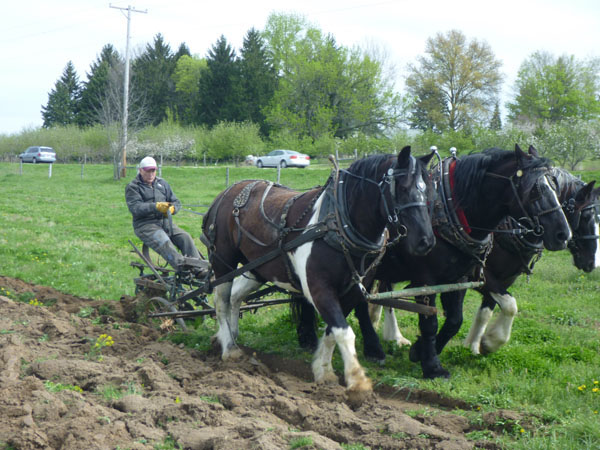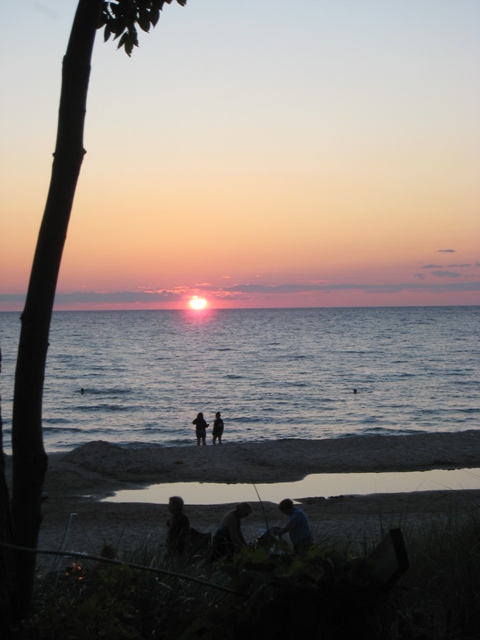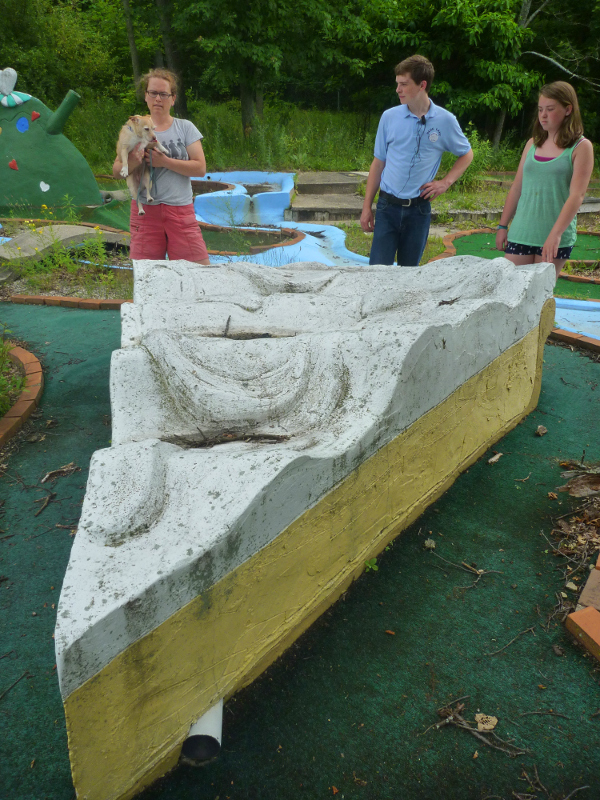More Photos Below!Gallery
We went to OHIO this year for Spring Break. Michiganders don’t usually do such a thing, so we thought it was high time we did. We wanted a roadtrip but not too big of one. We wanted to go where it was warmer and greener. We figured a day’s drive south might do the trick. Online it said southern Ohio flowers are out in the 2nd week of April but I thought this year’s warm weather might push it even earlier.
Two tips: When you go on a trip, have a plan — that you’ve checked out. And then bring the things you need.
Just a couple little tips.
— Both of which we skipped when we went on our Spring Break roadtrip just now.
I had an intense lead-up to the trip, with Henry doing his first-ever marksmanship event, an adult highpower event, two days before and me having my first-ever collectible outdoor books booth at the big local book show the day before. Ha! Talk about overdoing it. If I was sensible I would’ve planned and prepped for the trip several days before all that. But I was working. Oh well! We had a vague outline of things we wanted to do. Martha made a list and marked a map with all sorts of details. I added in my own two bits. But vital steps were missing — like some checking on whether places were open and when. Also an important “What city is this in?” detail. Then we quickly packed–and forgot a sizable chunk of helpful gear: the spare battery and charger for our camera, and chargers for our phones. (We don’t travel much or use phones often so we’re rusty along these lines.)
But everything worked out!
So, for some reason our local school has “Spring Break” near the end of what is usually late-winter. It’s usually still cold and brown here. So what people/kids are really supposed to do for this vacation is unclear, other than spend a lot of money and frantic energy on long distance travel. Maybe the name of this break is just an admin euphemism and its scheduling is unavoidable and because it’s “only” a few weeks away from being actually green and warm it’s considered close enough to call it Spring. Do all schools abuse Spring this way?
In the past we’ve occasionally been foolishly Michigander enough to reflexively “go up north” for spring break. Doh! Talk about it being still winter– So this year we decided to catch the closest green warmth we could and explore OHIO! We figured the southern part might be southern enough to do the trick.
And, yes, this was a TENTING trip. We have a big, cheap, simple, one-room Eureka 12-foot family tent. And we brought clothes for all 4 seasons, just in case.
I’ve long wanted to check out the ancient mounds of southern Ohio. Many of these are not Indian mounds, but pre-date them by a thousand years. Martha raised the good question as to why they don’t consider all these people to be the same, just separated by centuries and millennia. The historians did say that no one knows what happened to the mound-builders and that maybe they do still walk among us, so we just kind of can’t follow. Maybe they take this position because they can’t positively affirm a genetic/heritage connection. I wonder if they’ve done DNA bone testing. Anyway, the dozens of mounds along the tributaries of the Ohio River, going northward, are 2000 years old. Indians also built mounds, often among the older mounds.
I’ve also long wanted to explore the natural feature called the Arc of the Appalachia that naturalist friends recommended. It’s a place in southern Ohio where the Appalachian mountains loop northward, creating what is now the most bio-rich temperate forest enclave in the world, a rare treasure that its custodians are trying to piece together in a DIY version of a World Heritage site. The 2000-acre Highlands Nature Preserve a half hour south of Chillicothe seems like the heart of it.
So without thinking (alert!) we drove south on a Monday. By that I mean after the first hour we said “Whups, we somehow got off the freeway back there. Oh well, let’s just stay on this smaller road, it’s going the right way, after all.” Mistake. We spent the whole day driving slow in flat, dull Sprawlsville of northeast Ohio trying to get to the central region. Tip: If you want to get somewhere and then explore just get there then explore. Don’t explore along the way. Especially if there’s no reason to and there’s nothing there. I suppose we didn’t know there was nothing, but we could’ve had a strong suspicion.
We made this same mistake once on a drive to California. We started taking backroads right away and spent a week spaced out in dullsville dead-small-town minimall blighted prairieland before getting to Kansas. Then we had to put the pedal down and blaze through the more exotic country we should’ve been rubbernecking through. Doh!
Well, we don’t travel enough to remember lessons and we hate freeways so I suppose we can’t be blamed, but it ain’t smart.
We woke up as the only people in a state park south of Zanesville. We visited a highly recommended donut shop there in the morning. It was nothing special. Jane and Michael need to be a bit more descriptive in their tips. They tend to apply their gushing as equally to kitsch as to wholesome or distinctive. Crappy suburban donuts might be quaint to NYC people, but they’re familiar to us – in a bad way.
We waited around after that until Tom’s Ice Cream Bowl opened. Now THAT was worth the wait. It’s the real deal and worth a stop if you’re passing through. It’s vintage. There’s tile, wood, paper hats and bow-ties. They make their own ice-cream. It was good.
I wish we could’ve visited the Zane Grey museum in the area but we were behind our schedule, thanks to our no-content previous day of dawdling.
We then drove back west and visited the Motorcycle Hall of Fame. It’s a great place if you love motorsport. It still hangs in there if you appreciate motorcycles. If you think about it, it’s not about the motorcycles but the people behind them. So it’s about people in motorcycling — that’s who gets elected to the Hall. Those stories are fascinating in many cases. Since I’m not into motorsport in half the cases it was not so much. Also, it’s the US Hall of fame. So half the emphasis is on dirt-track. Since I’d guess motorsport is overall strongest in Europe there are, uh, gaps. Still, another stop well worth the while. The display for the Vietnam vet who rode around the world without legs in the early 70’s is amazing: his dirty bike with all its homemade add-on’s (a piece of 2×4 in a canvas handlebar bag — for kickstand, maybe?) plus his fake legs are there. The display for the twin sisters who were early ambassadors and set some adventure records of their own in the 30’s, maybe it was. Maybe they were triplets. There’s a big photo. They were lookers. I enjoy recognizing sassiness in old photos. A lot of old photos are poker-faced but sometimes ya just can’t hide a bold spirit.
Then we headed south for our next stop: the bike museum. Ha: we ran smack into another planning error. I’d thought the museum was near Dayton and mentioned it but got sluffed off and didn’t pursue it. Turns out Bremen isn’t the same as New Bremen. Thankfully our mistake was on our way to Chillicothe and the Ancient Mounds.
Chillicothe was a nice-looking, active, well-preserved town. But we were late and didn’t get to explore it much.
We noticed that all the farms along the way so far were very tidy. We appreciated the old houses we saw, too. Older than in Michigan. Many were tall, narrow red brick with tall narrow windows. But there were all kinds.
Even so, the devastation of the small town keeps getting worse. Some were active, but most were neutron-bombed. The buildings were there but not much else. Some places are getting Detroited and the towns are being razed. Freewayexitville has triumphed with its superior locations for tanning salons and easy credit.
We noticed a couple shocking details.
Even modern sprawlish suburban areas are now food deserts. The small towns certainly are. Most rural people have to drive about 30 miles for groceries now. Good job, smart people! It was never smart to ditch your local folks just to save a little so you could spend more. But suburbans are stuck now, too.
Still, some small towns do have little groceries. They’re looking worse, though, seedy and rundown. They’re converging with the Dollar Generals which are everywhere. Dollar Generals sometimes sell “groceries” — meaning, boxed fud.
I have to say that rural people seem to be declining, too. Now, we ran into quite a few interesting, pleasant folks. But the vast majority is scary. I don’t think it’s just snobbery. Obesity is beyond rampant as is tattooing. All ages are in on it. Combine this with mouth-breathing monosyllabism and it’s scary. Fashion is pro-sports, sweats, camo and wife-beaters. The menfolk often seem edgy and violent. Loud profanity in the gas stations around kids. There’s a sense that many have done time.
In short, it seems like the countryside has been ghetto-ized. I suppose it’s because the jobs are gone. But every doublewide had its dish. I actually have doublewide pride. There’s no reason for trailers to go with despair or even for poverty to go with despair. Nobody’s starving and they have healthcare and did I say lots of tattoos? Meth, the rural crack, bubbles below the surface. I don’t know what users look like but if their style has a look we just got a big dose.
Michigan has this blight feel, too. Maybe we were shocked just due to the size of the dose. It’s not often that we visit a lot of small towns in a row. It did make me want to flee the country. But then I have the hunch that it’s a global thing. The provinces and urban areas alike can be dark.
It’s the “survival party” of consumer response. And even those who live in the deep jungle are caught in our paradigm. The snag, for me, isn’t literacy, tats or fashion per se — it’s when it seems like the spark goes out. But maybe I’m overreacting and once you get to know ’em they have their ups’n’downs like anyone. : )
It also struck us as weird to think that they’d all been at least through 8th grade.
After we got home I heard an NPR radio interview about parts of the population that are hurt in the current healthcare crisis but which are “unsympathetic” and thus invisible due to obesity, disability, mental illness, addiction and crime, especially as related not to unforeseen events but to the results of bad decisions, and who are proving to be really hard to help. I had a feeling of who they were talking about.
On the bright side, darn, Ohio farms are tidy. About half the farms in Michigan seem fairly alcoholic. I’m not against a messy farm. I think they’re cool. But I suppose many have a dark side. Then again the tidy farms can be a bit intimidating. It makes me wonder what it would be like to grow up in such a place. — Not a leaf out of place. Gulp!
A really bright spot along the way was when I saw some guys out plowing with horses. They really do use them — in soft, technical fields and in strategic woodlots. But they have to get fit each spring. The walk-behind plow was the most impressive in its elemental simplicity. The team of Belgians dragged it along on its side with the farmer walking behind when he got to his row he’d pick up a handle, talk to the horses (they’d move a few inches this way or that) then get going and a perfect furrow of dirt would turn over as away they went. The other team used a sit-on-top plow and 3 Percherons. They said their young Amish neighbor would run 8 horses at a time! Very friendly guys, young and old, they told us to drive around the “big house” if we liked, to hang out and watch.
This farm was set up like so many with a big old house on a hill and a newer ranch house alongside. I think the retired parents would live in the new house. But another common set-up was a third house, a modular or doublewide where the young family would live, and the Old House would be abandoned, still looking fine but with vines growing all over it. That seemed sad but economics rules the farm like everything. I’ve also heard that in 1960 a family could still make a living off of 100 acres. When I asked a family friend farmer in 1990 about it, he said a family needed 1000 acres. He said he now lived off of what used to support 10 families. And, the biggest joke was that on the side he had to be a full-time prison guard to actually make ends meet. Healthcare and a pension, I suppose. But that was considered easy duty to these folks. Maybe a time they could rest up from their farm duties. Of course, it’s no laughing matter. I wonder how many rural farm people “supplement” their traditions with prison work. I think it’s common today.
Whew — I start out with sweet plow-horses and get back to social devastation. Well, a country gets what it deserves, I suppose.
The state campgrounds charge $24 for a tent, $26 for a fully-hooked-up RV. Motels are, what, $35. KOA campgrounds charge $55 for a tent. Crazy!
When driving across the nation we’ve noticed — and heard — that tenters are biased again since, apparently so many are homeless/squatter types.
My new prime directive is to head straight for State/National Forests. I’ve never needed no steenking campsite. Public campground campsites are STUPID nowadays: small and ugly for the most part, and now expensive. In a public forest one can scope out a river, a nice overlook and pick the world’s best campsite. But this takes a bit o’ planning and a topo map. Gotta know which 2-track to take. I suppose a GPS would help.
We camped at one nice park overlooking a reservoir. An RV had the prime overlook site. As it came to sunset I took a walk down to the water and passed the RV. Its generator was on, making a racket, it was playing loud TV, the door was open, but nobody was home. A half hour later a big truck roared up. On and off during the night a loud construction generator would turn on at the edge of the campground. I woke up and went out to hunt it down and chop its powercord. It was fenced in.
The Ancient Mounds were really something and deserve their own article and your googling. I think that some are, like, 5000 years old. And they contained abstract art that seems at least as good as today! There were hundreds of geometric mounds and earthwork designs in a 200-mile stretch of Ohio River valley. And, catch this: the squares were often the exact same size. Many of the circles were the same size. The arrangements of big and little circles and squares and hexagons are all different, though. Moreover, I’m pretty sure the museum movie said that these people didn’t live in villages. They were dispersed socially. They’d gather for ritual only, at the earthworks. The geometric earthwork culture is called the Hopewell. The structures were built to orient to celestial events with burial mounds within the enclosures. We’ve discovered many of them only because of AERIAL observation. These earthworks, miles of walls up to 20 feet tall, were built only by people carrying baskets of dirt. That’s a lot of work. Hundreds of thousands of man-hours. Yet there was no slave culture. For a people that didn’t have written language. And who were also vastly superior in abstract (decorative) art. Somehow they had a lot of free time, and just plain time, to do both high art and intensive manual labor and eat and raise a family. What’s more, many of these mounds and earthworks were buildings, not just dirt, at the time. They were surfaced with clay plaster and painted. With buildings on top. I’m suspicious. C’mon, UFO’s anyone?
Actually, I sell a huge glorious coffee table book featuring them and their art and history called “Hero Hawk, Open Hand” at my eBay Store.
Back to being a bit sad: in the 1880’s — when places like Harvard were already rockin’ and Indians were speaking before Congress (I think) — these structures were considered of zero value and were razed and plowed over. –The biggest human achievements on earth. Like the pyramids only not done with slaves and spread horizontally in ways that the builders couldn’t even see (!!!) rather than going upward. Easy to see. And folks must’ve noticed that the apertures lined up with the moon now and then. Yet considered worthless.
I suppose it’s because back then the scrabble for cash was even more desperate than today. The Indians themselves were considered worthless though many had entered into deeded and other business relations with them and had intermarried and such. Why was the Indian considered sub-human? — Only because he had some amount of property that the white was trying to steal. Pure theft. No other motive.
Thankfully, a couple Harvard dudes came along the Ohio area, one a local doctor, and did some amateur archeology — undoubtedly ridiculed at first by “real” degreed diggers — and saved the Mounds! Actually, their work made for the first book published by the Smithsonian, so they did get respect. (“Ancient Monuments of the Mississippi Valley” by Squier is a gorgeous old book.)
The next day we explored the Highlands Nature Preserve. I’ll show you a few photos. It’s a special place, thankfully saved from being chopped up into small cottage lots.
Then we went to the Serpent Mound, another eye-popper: a half-mile of snaky mound in a gorgeous snake pattern, with coiled tail and a mouth eating an egg (maybe). It’s built on a long ridge overlooking a river, with the shape made to fit it perfectly. Each of the bends points to a different major annual celestial event. Wow. An overlook platform lets you view most of the snake.
I didn’t know that there are Mounds made in all sorts of animal and human shapes. It’s really boggling, but I guess that’s why they were called Mound-Builders. Some of these peoples lived here before the Aztecs and Egyptians. What was really neat was the city built at Poverty Point. We have to go check it out. It has streets built on arranged in ray patterns designed to follow the sun. Maybe 20,000 lived there. Or was that Cahokia, another place we have to visit.
One neat angle that I haven’t seen anywhere it exists yet is: Are there any actual replica mounds created as they were thought to look during their active years. That is, any mounds that are clay-plaster surfaced and painted with symbolic shapes with thatched buildings on them. That would be the BEST to see. Today it looks like soft landscaping, but when in use it was ARCHITECTURE. It was well-finished built structure with stairways and such.
It was interesting to come across a couple plaques about a guy named Simon Kenton as we drove through a valley east of Dayton. He stole horses from the local Indians, was caught, and had to run the *gauntlet*. — Nine times, in the various villages. I guess you only lived if they liked you — they’d just whack you some if you were cool.
Then we visited a couple caves. Ohio Caverns are small but picturesque, an immaculate private attraction. Next we visited the nearby Zane-Shawnee Caverns. Whoa nelly! The Shawnee Caverns were bought by an Indian and are now part of tribal land. It’s some acreage that is also used for pow-wows. It has a lot of character, maybe too much for most people. It’s quite run-down. Well, it couldn’t get more run-down and still function. The tour office is seedy. The nice, sweet guide was seedy. This isn’t all bad. You can relax and there’s more to see. In the gift shop I saw that the owner of the cave is also an artist, and who often specialized in nude maidens. The veneer of marketing is thin.
You can’t get away from the fact that seediness is a bit sad. But maybe only if the people are sad? They didn’t seem sad, maybe. Just because life is shorter and teeth are fewer and waking hours aren’t always conscious doesn’t mean– I suppose the downside would mainly be the “checking out.” Giving up on ambition isn’t the problem, but if the eyes glaze and pain starts playing a starring role, then– But pain has all types of “looks.”
Well, as she was talking to us she got out 4 flashlights and checked them. All glowed a weak yellow. Then we went through a door down some creaky stairs. As we went down I noticed overhead timbers were broken and collapsing. The cave was nifty, but smaller and muddier than the other one and not as colorful, but with more vertical, including submerged or extra-tight levels we couldn’t enter. Water was on the muddy floor/path. Christmas light-strings started appearing as lighting. I’d forgotten my camera and I realized that I should’ve brought my own supergreat flashlights — sweet tools only help when you bring ’em . Doh! Then we came to an area where our guide said the lighting had failed so she brought out the flashlights. I noticed that she had one that burned brightly so I relaxed. I’d been enjoying the thought that we might have to find our own way out. It added to the sense of adventure. I get very claustrophobic so I was working on acceptance. It was actually pretty fun in that regard. I actually got a bit more panicky at the fancy cave due to the crowd of people with us. Our guide had a nice presentation and interest in the cave and the science. She told us about how a guy once tried to get from their cave to the fancy one and never was seen again. It was interesting how her patter was similar to that of the other cave just a full step lower in polish. When we came back out into the sunshine pitbulls chained at a trailer next to the trail were barking at us.
What’s a bit weird is that these caverns are treated the same in the travel guides.
The nearby town of Sidney seemed alive and vibrant. I wish we could’ve detoured there a bit. It had “The Spot to Eat,” a busy vintage diner (indoors and car-service) where time hasn’t skipped a beat. (https://www.thespottoeat.com.) Across the street is Louis Sullivan’s last building, a gorgeous Deco “jewel box” bank. All the houses in the town seemed to be on parade.
Also nearby, near Bellefontaine, are the two Piatt castles — stone home castles. The houses of this region are often impressive but these two really do stand out. We went to visit but skipped that important step of seeing if they were open: not yet for this season. Doh! The homes are called Mac-A-Cheek and Mac-O-Chee and have been both lived in and on-tour for 100 years. Odd names, huh? It’s a family owned project. A great-great-granddaughter who lives there is blogging about this strange set-up as she goes to college. Seems well worth visiting. Available for events. www.piattcastles.org
Another castle is Chateau Larouche, which was open. Located in Loveland, it was the life work of an eccentric guy who started an order of Knights to help him work on it and maintain it. They still volunteer to keep it going. It’s a neat place to tour and explore — and rent for events. From their website: “Any man of high ideas who wishes to help save civilization is invited to become a member of the Knights of the Golden Trail.” www.lovelandcastle.com.
I like grand interior spaces. A big fireplace is cool, too. But fanciness has different looks. You don’t need a castle. One could find an old urban factory with high ceilings of stone and brick with a big hearth at one end and balconies around the perimeter and a big kitchen — it would be great to turn such a place into living spaces and events center. I’d still be hip to that! I bet Detroit still has a few. I suppose it’s called loft-living, but I’d want to keep a big central space and big kitchen. (It’s appeared in my dreams for decades–)
Then we started driving north. We detoured east around Dayton on our way to the real New Bremen, home of the Bicycle Museum of America. On our way we were thinking that maybe Yellow Springs was around there and that it had a famous ice cream shop and didn’t it have a famous liberal arts college, too? We searched the map, a new, plastic Rand-McNally. Nothing. We were driving along and suddenly we saw a city limits sign: “Welcome to Yellow Springs!” We looked at the map: nothing. We drove into a city of a half dozen blocks in size with a completely prospering downtown. Every building was being used to its maximum for culture. No tanning, no easy credit. All local grocery, cafes, art, newsstands, boutiques. A hippy town!
–But not on the map!
This has never happened to us in all our travels. It’s a town of 3500 according to Wiki, with, what, 1000 at the college. Oh, I also see that Antioch got into the news a couple times on PC issues in recent years.
It seems like a nifty, thriving town. I’ve also read that people from outlying areas often drive through rubbernecking at the hippies, taking photos of mohawks without permission and such, so that it has picked up a reputation for having an attitude. I suppose that any small town without tanning salons and easy credit would look like it’s from another planet in the USA nowadays.
We messed up a bit with our planning again, in that it was now Good Friday and we were hoping to make our two main attraction visits that day. Doh!
Thank heavens the bike museum was open! What a wonderful place. It has the best 1800’s bikes displayed that I’ve ever seen. It’s wonderful to linger over their ingenuity, variety and craftsmanship. Sadly, the museum lacks 30’s-70’s road bike and touring bike representation. Even significant mt-bikes aren’t on display. A sizeable chunk of modern bikes on display would fall into the “no impact” and “quirky” category, but I suppose they rely on donations to a large extent, although there’s an original Schwinn family tandem that cost $100k. Still, it’s a must-see!
Both the museum and the town are funded by the CEO of Crown Equipment, a major fork-lift maker who used to be a major antenna-rotator maker. Interesting that once you figure out a profitable way to make things it might be somewhat easy to make something else. It’s the making that’s the trick, one that the USA is hopefully learning all over again, but with less repetitious work injury.
New Bremen has a historic feel but much of the town seems freshly built. Or else it’s just immaculately cared for. Some locals told us that this is courtesy of Crown. We did note, though, that though it was upscale in polish and several blocks in size with a world-class factory on its outskirts with ancillary business and offshoot factories flanking it, that it had no restaurant or grocery.
Part of the Erie Canal system runs through New Bremen. That was neat to see. At some point it was re-dredged, all by hand, by the village menfolks and boys. A photo on a plaque tells the story. Maybe it was during wartime and no horses were available. The photo shows guys in all kinds of attire down in the bottom with shovels. Gettin-er-done.
We next tried to stop by the Airstream Trailer for their daily 2pm factory tour. This is when we fully appreciated that it was Good Friday. Nobody was there. Doh!
Then we drove home. 1000 miles in 5 days.
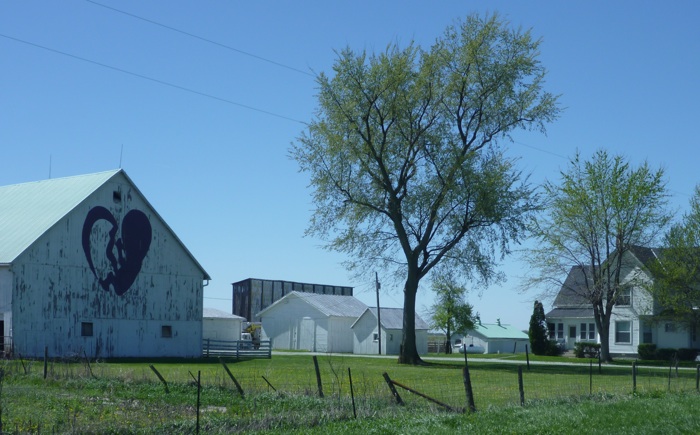
All the farms were tidy. This one came with a little extra something.
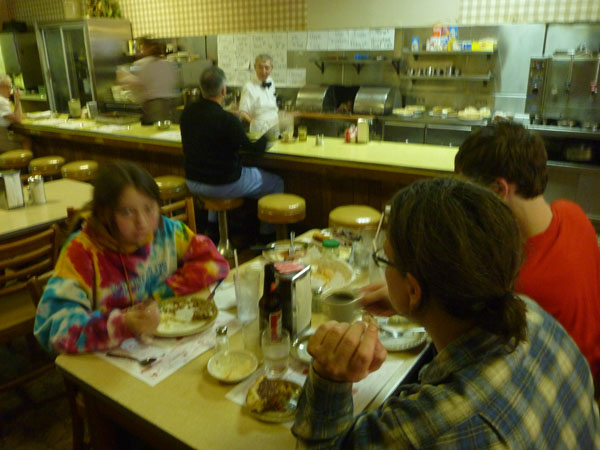
Bowties rule.
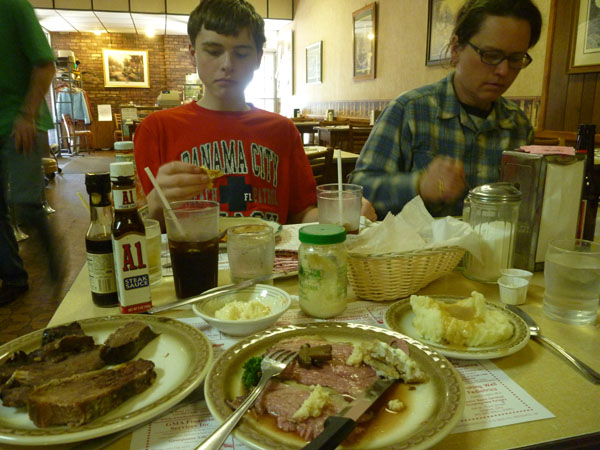
I had 3 meats for lunch. Tongue rocks! (It really does.)
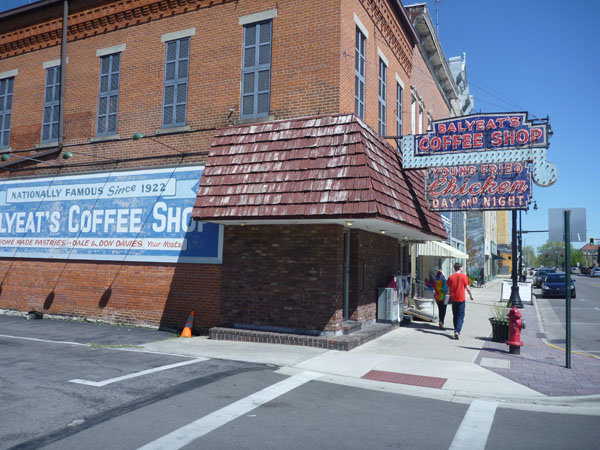
Balyeats is a super, classic diner-ish restaurant with farm-fare and beer’n’wine.
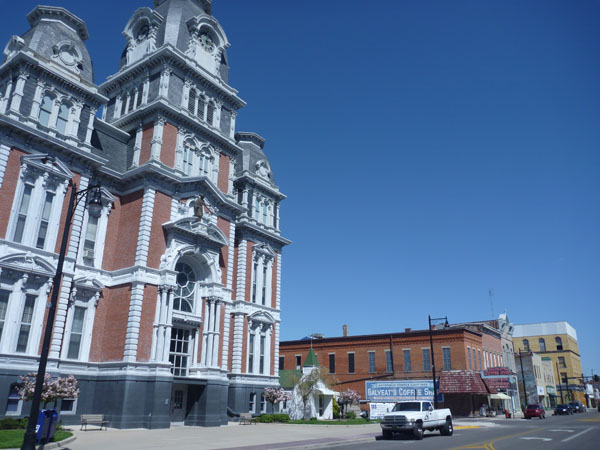
Balyeats is next to a nice courthouse in Van Wert. I saw a bike shop down the block, but we were on the move.
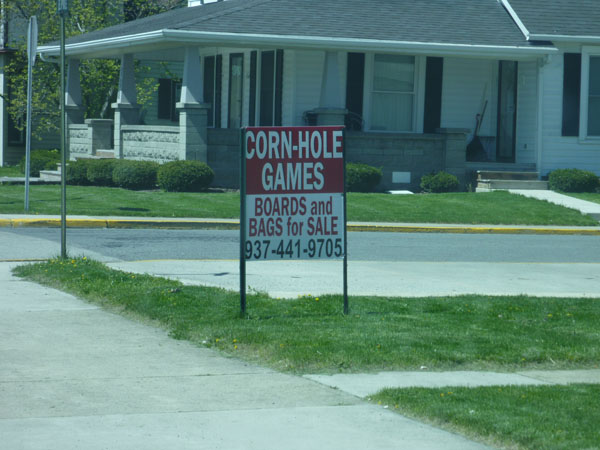
Funny.
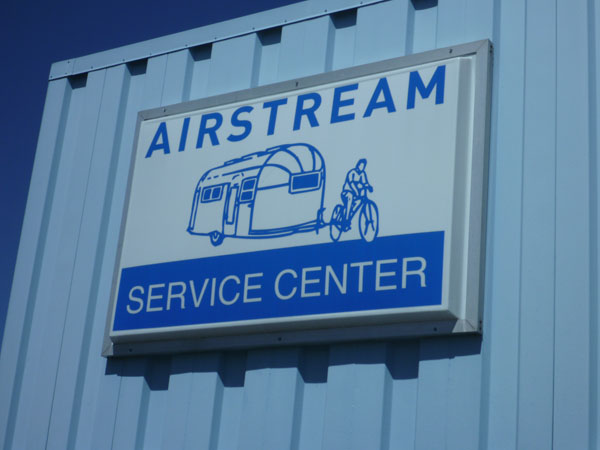
I bet it’s a good factory tour.
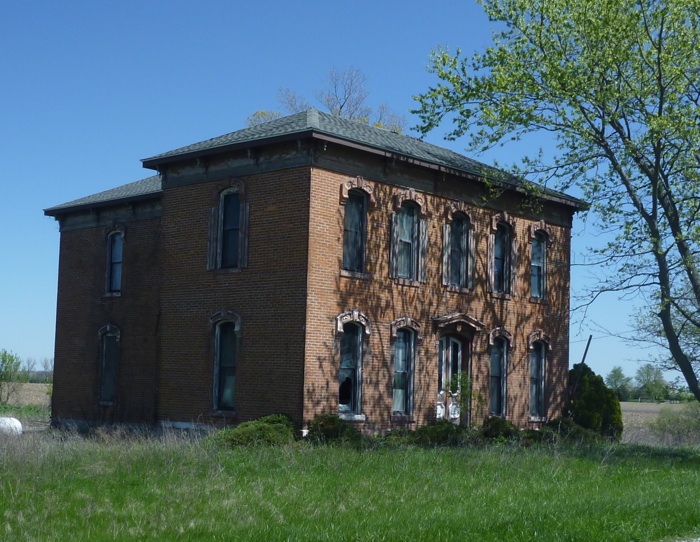
Ohio was full of wonderful brick early-era houses, often on farms. But sometimes farms had empty old houses next to doublewides that the family now lived in. Here’s one.
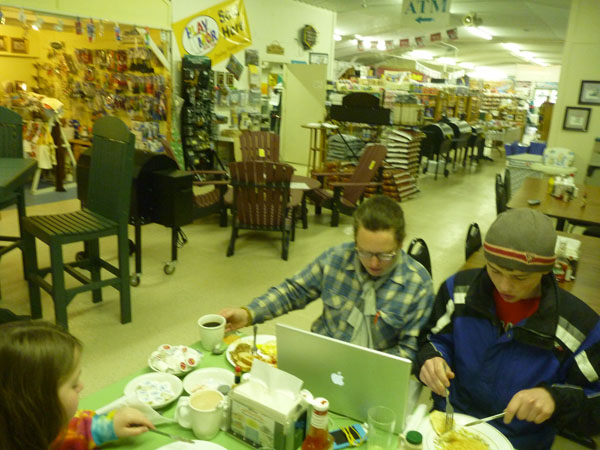
This was a weird place to have breakfast. It’s in a gas station flea market. We were the only ones there. It mighta been cool if it had been rockin’. I hope it is sometimes. We were told to go there by a guy who lived in a very nice town that had no restaurant. We had to drive 10 miles into the countryside to find this eatery.
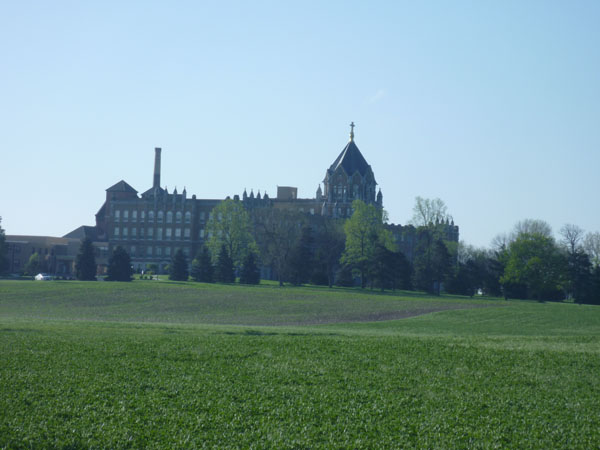
A monastery (now retirement home I think) on the way to our gas station breakfast. This area had what is called the “Seven Sisters” — seven gorgeous Catholic churches. And a nunnery retreat and the nearby ex-monk monastery.
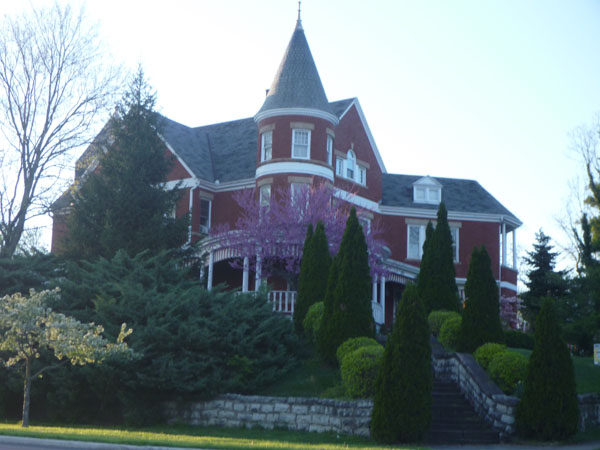
Ohio towns were jampacked with well-kept grand old homes.
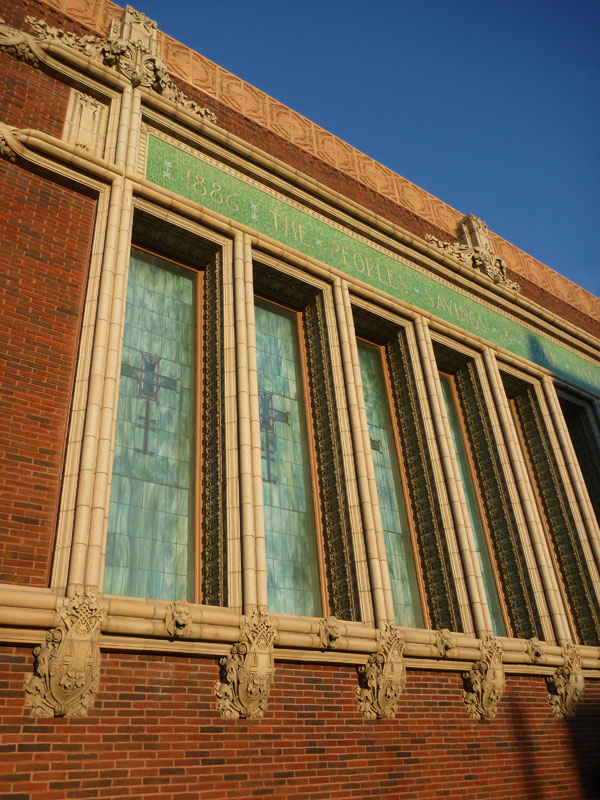
Side view.
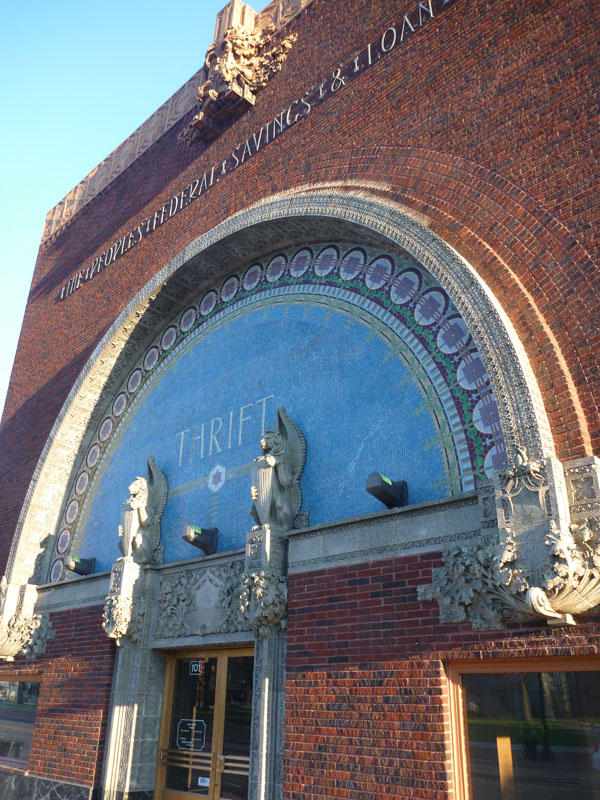
Louis Sullivan’s last building, in Sidney. Across the street from the “Spot to Eat” or some such diner. I don’t know which was cooler. They’re both required for this town to be a town.
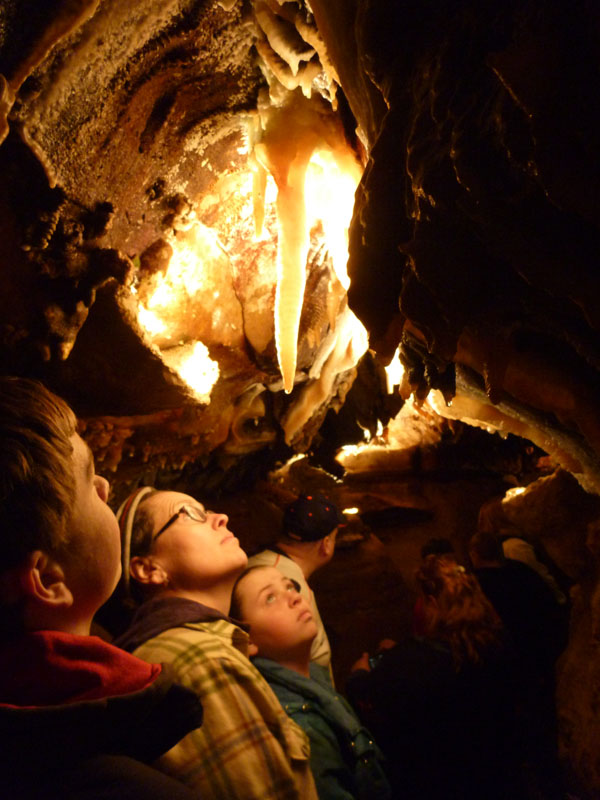
Ohio cavern view.
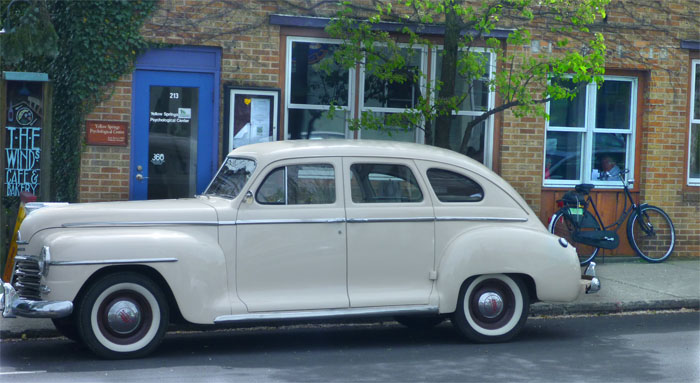
Street scene in Yellow Springs, the town NOT on the map.
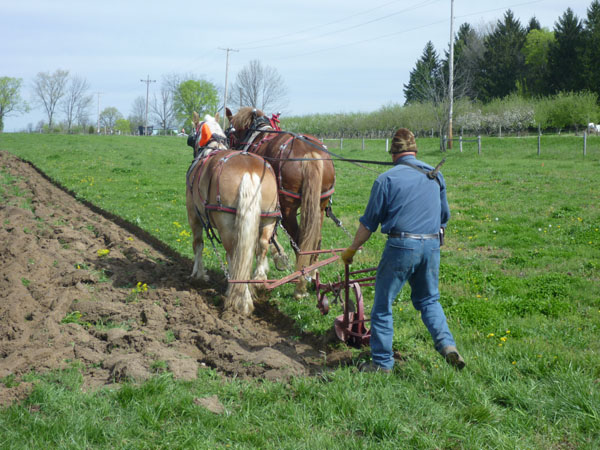
Direct drive. This was impressive. So simple. How it was all done back in the day. By my grampa, even.
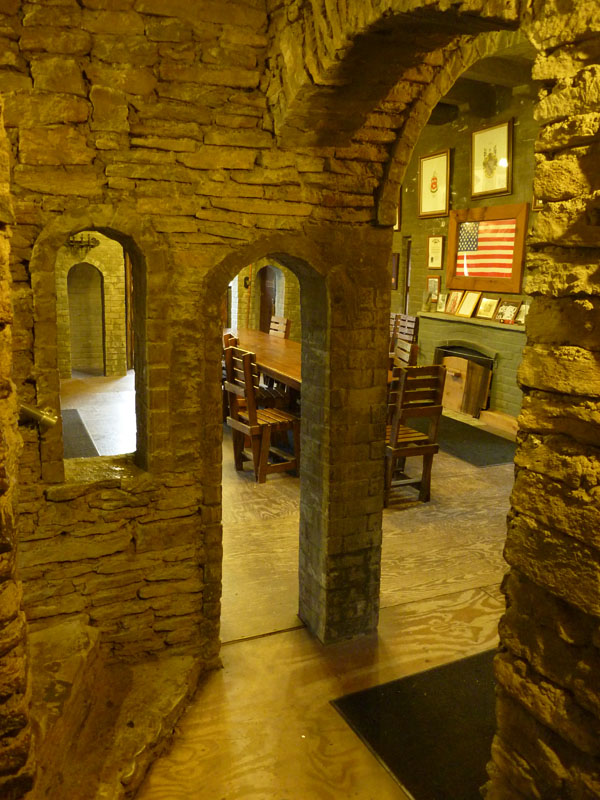
In the castle.
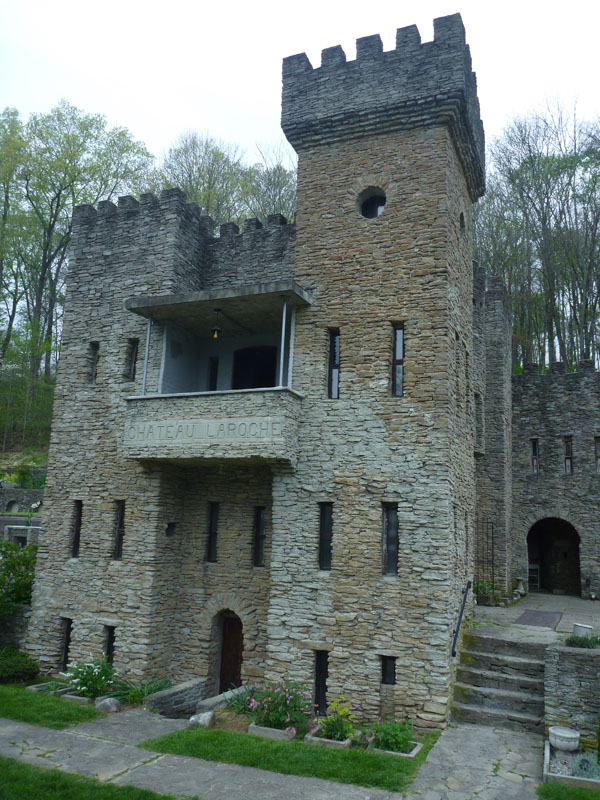
Another castle, more homemade. One guy did it all.
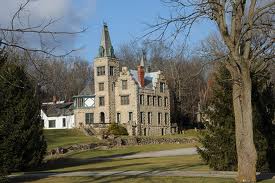
One of the two neighboring Piatt castles. Available for your party.
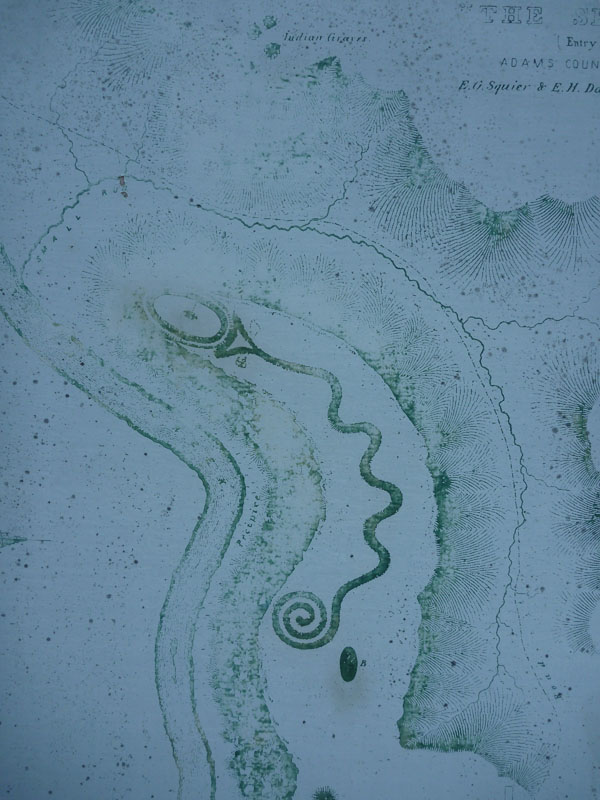
Old drawing of Serpent Mound.
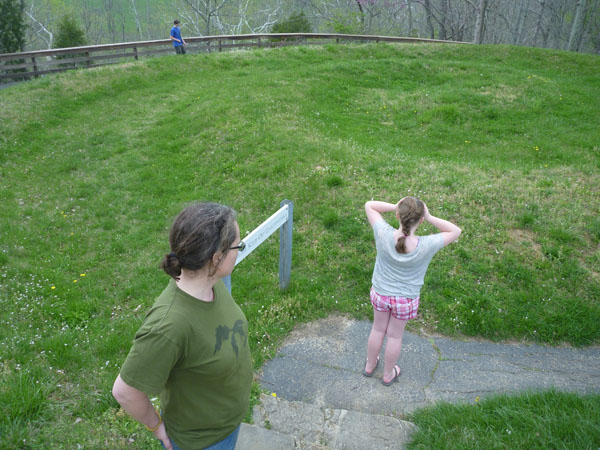
Tail.
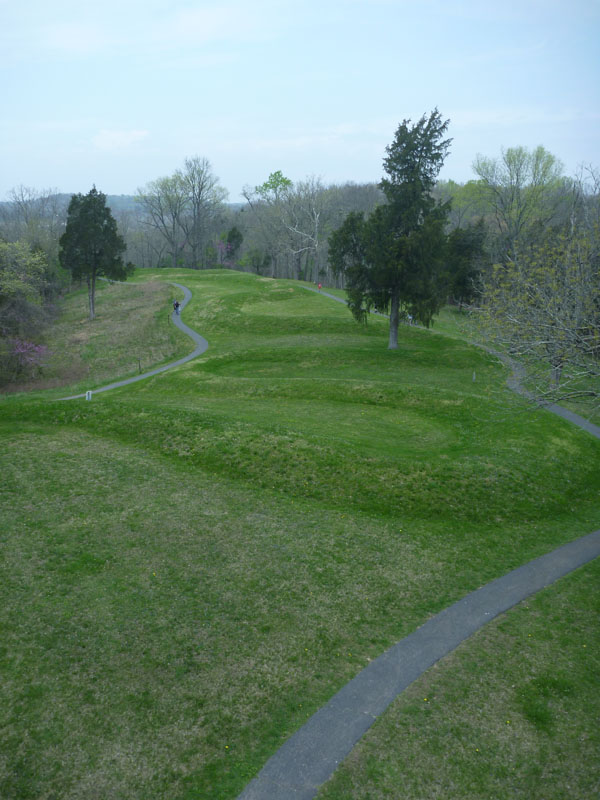
Serpent Mound — view from tower.
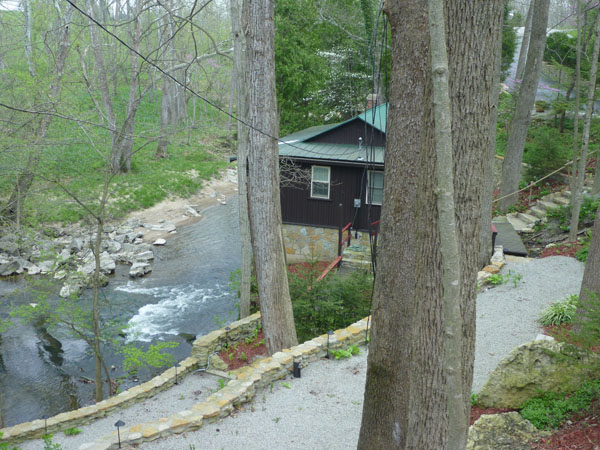
Cottage along the creek outside the Preserve.
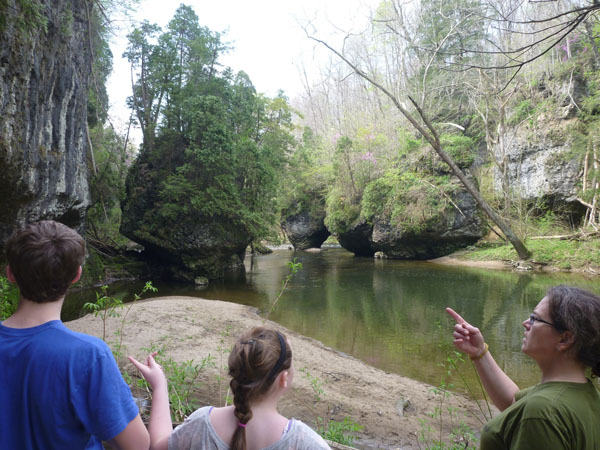
Down in the Highlands Nature Preserve.
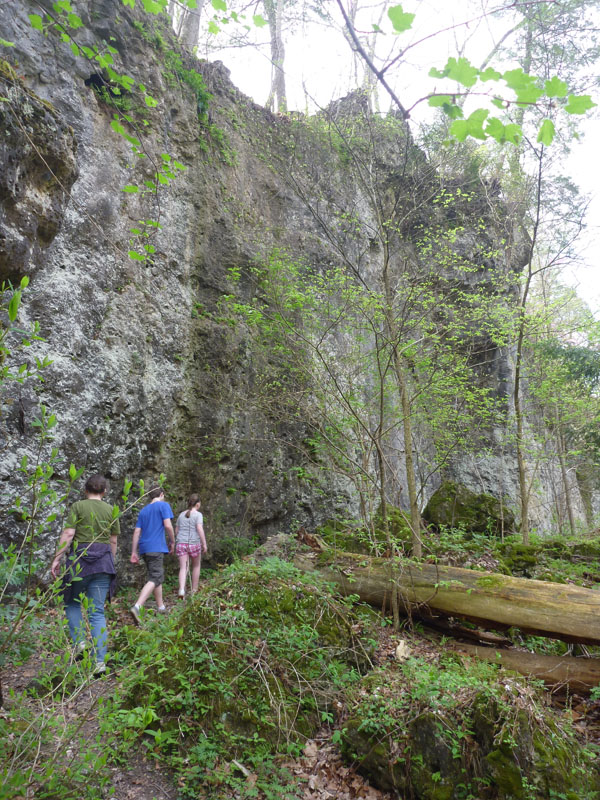
A walk in the Preserve.
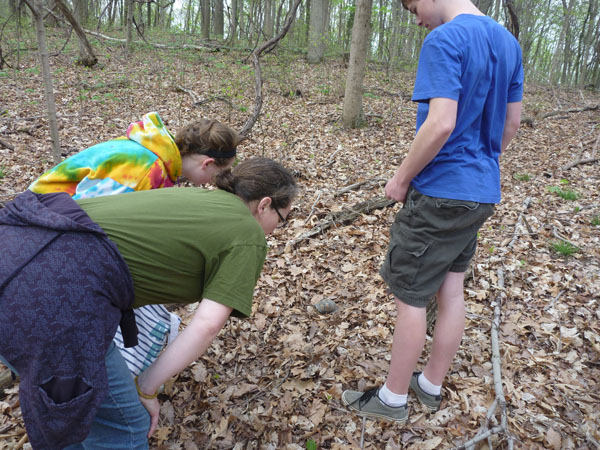
Saw a box turtle on a walk in the Preserve.
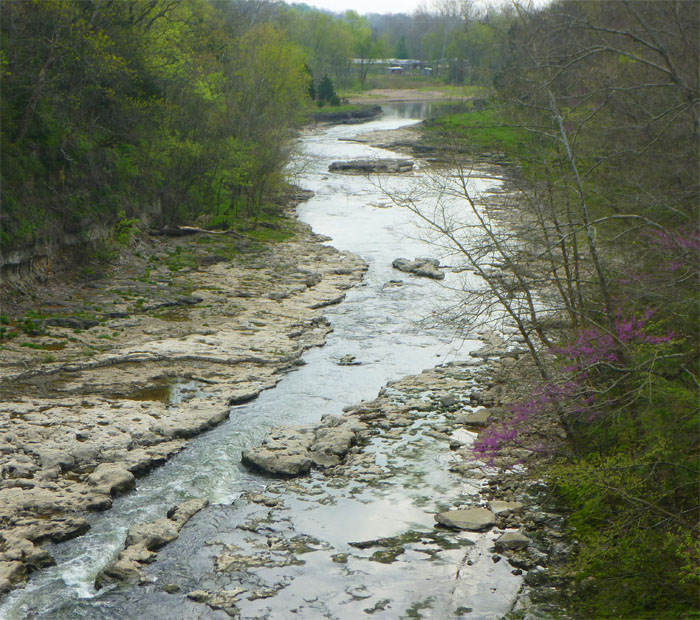
View over a bridge on the way to the Preserve. That creek is FAR down there.
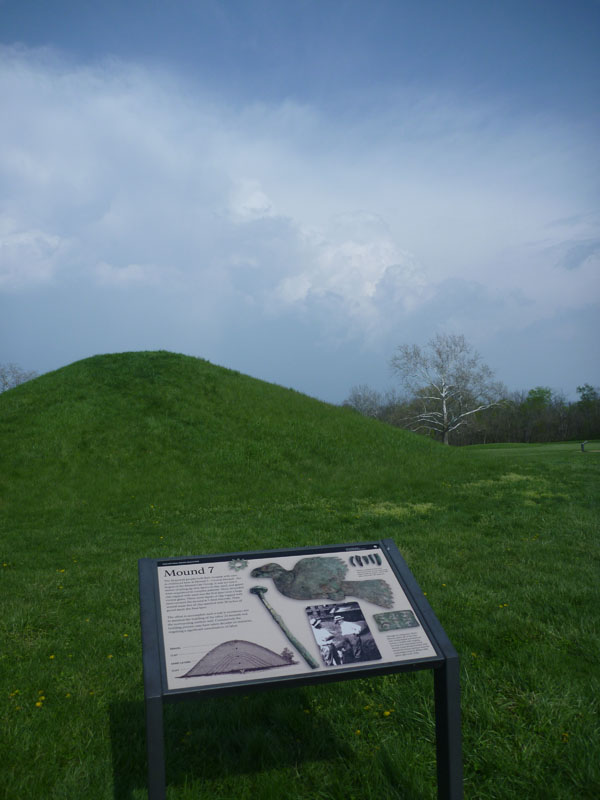
A Mound.
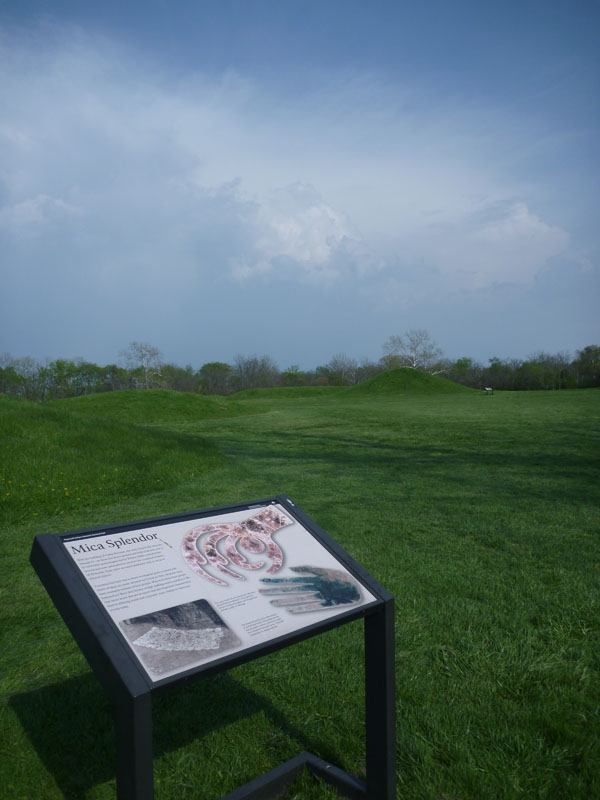
Mound, cloud, and plaque.
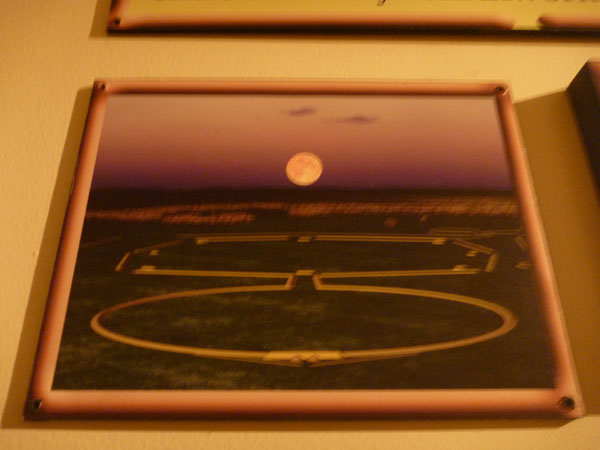
Line ’em up!
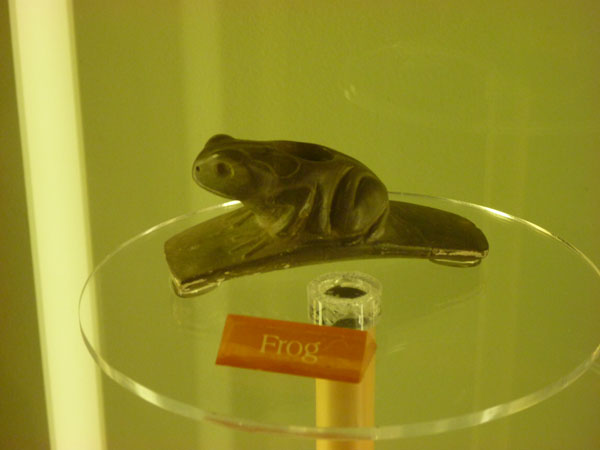
Hundreds of pipes in one mound.
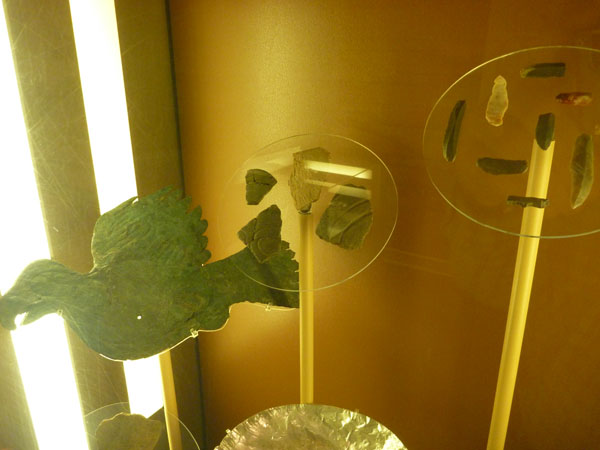
A big unique thing about this people was they used small stone blades called bladelets. That’s what the plaque said.
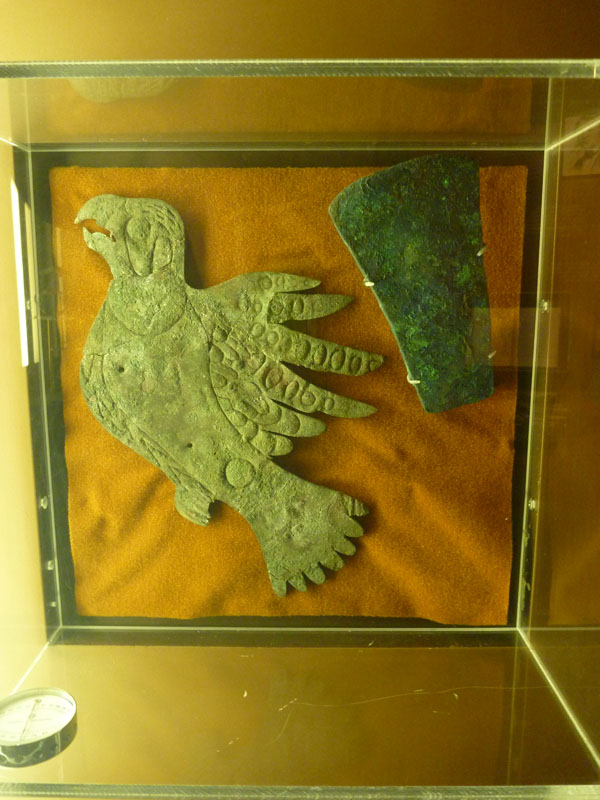
Nice copper hawk. Hero hawk.
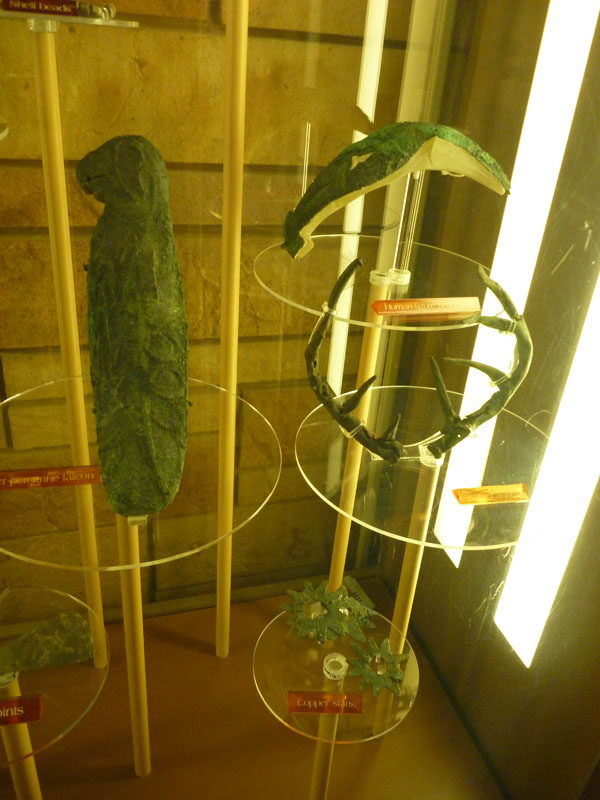
I guess the Hopewell had a trading network. The movie said something else, but whatever they did, it was tricky. They got copper from the Keeweenaw. Copper antlers, here.
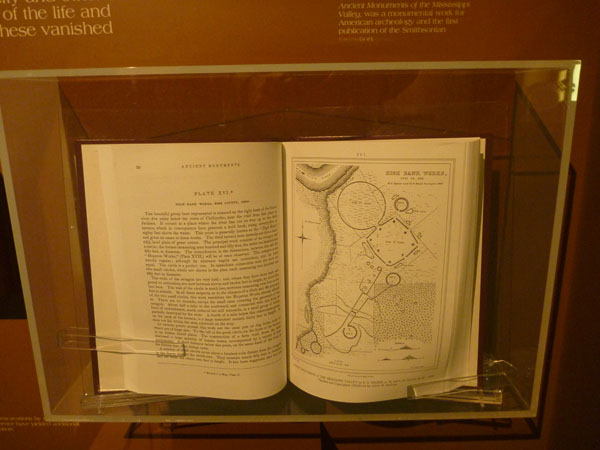
Old map of one of the hundreds of geometric earthworks in the Ohio Valley.
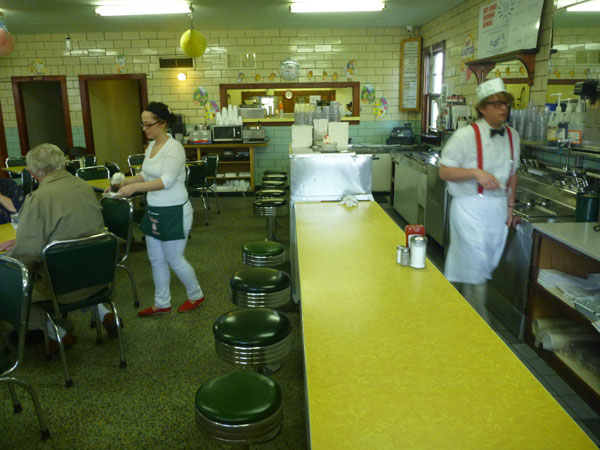
Action.
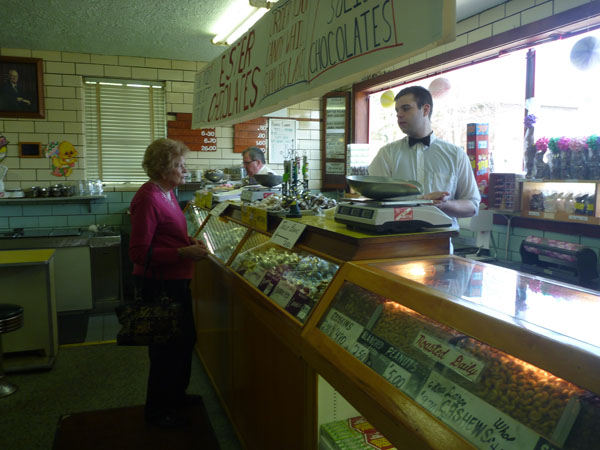
Service with a smile.
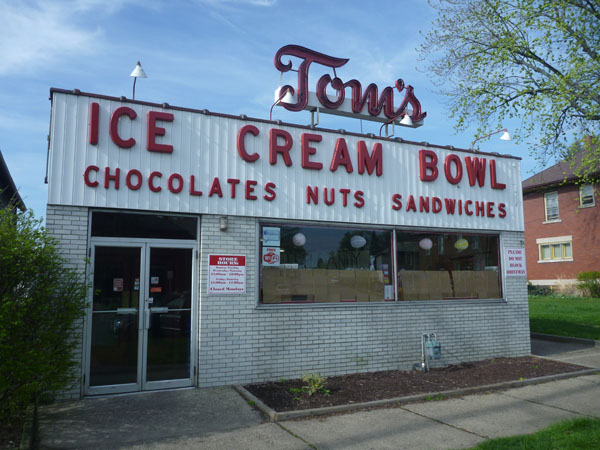
Tom’s in Zaneville. Don’t miss it.
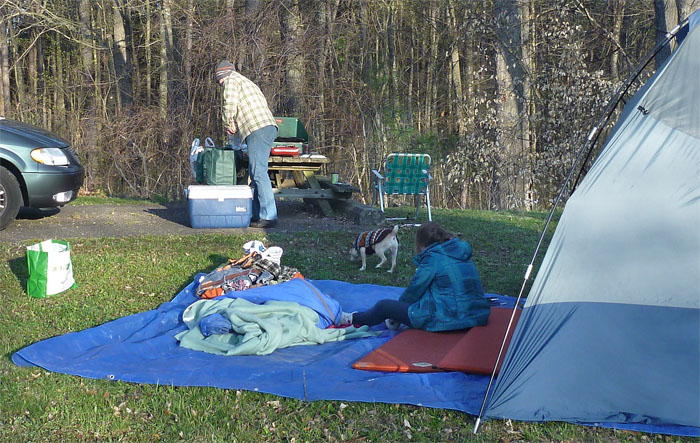
How we camped.
